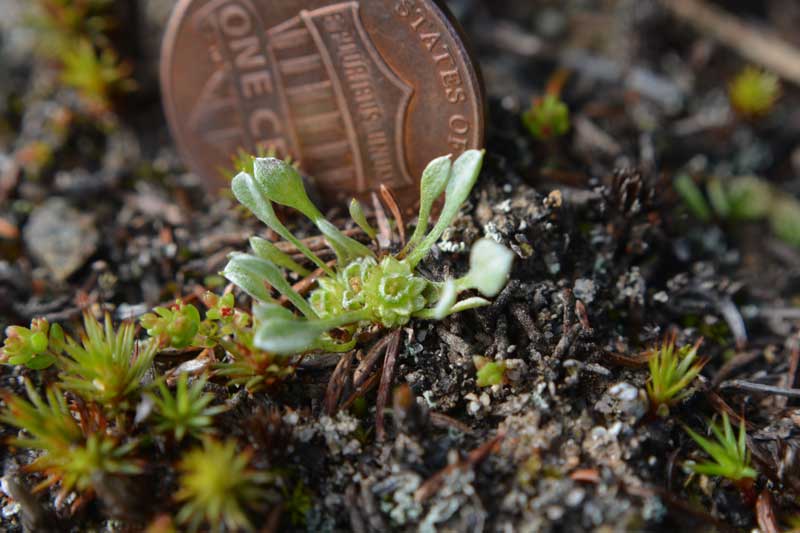Only Known Population Found of Rare California Native Plant Not Documented in Almost 30 Years
“A truly thrilling find.” No photos of live Ancistrocarphus keilii existed until now.

May 17, 2023, Sacramento—Today, the California Native Plant Society (CNPS) and Santa Barbara Botanic Garden (the Garden) announced the “re-discovery” of a native plant species not documented in decades. Prior to the new finding, the Santa Ynez groundstar (Ancistrocarphus keilii, CRPR 1B.1) was known only from very old records and one or two occurrences.
Recently, collaborators from CNPS and the Garden, including CNPS Rare Plant Program Manager Kristen Nelson, Santa Barbara Botanic Garden Ken and Shirley Tucker Systematist and Clifton Smith Herbarium Curator Dr. Matt Guilliams, Santa Barbara Botanic Garden Rare Plant Techs Sean Carson and Kevin Mason, and Center for Environmental Management of Military Lands Lead Botanist Dr. Sarah DeGroot, pieced together information from old records and primary sources and were able to obtain permits to search the location on Vandenberg Space Force Base (VSFB) where the plant was known to have existed. The search effort was coordinated with VSFB Botanist Luanne Lum. Location information provided by Dr. Dieter Wilken, research associate with Santa Barbara Botanic Garden, made the relocation relatively easy, said the team — “a truly thrilling find!” said Nelson.
The Santa Ynez groundstar was originally described as a new species in 2004 from analysis of dried specimens (which is often how new species are discovered). Dr. Wilken is the only person to have seen the groundstar since its recognition as a distinct species, and only a few living botanists had ever seen it in the wild before its new species classification.
“Plants such as this are or could be on the brink of extinction and we can only confidently say they are doing okay once we get eyes on the ground and find them,” said CNPS Rare Plant Program Director Aaron Sims. “Even though this species has been found, the population is extremely limited, and it’s important that land use changes do not occur.”
Work to update outdated plant occurrence data can require significant effort and research, but they are key to informing conservation efforts and staving off species extinction. A recent report by NatureServe found that 34% of plants in the United States are now at risk of extinction, with plants in California among the most at risk. “By bringing attention to them, gathering new data, and fostering conservation attention and action, these species have a fighting chance of survival,” adds Aaron Sims.
“It was a true joy to find and observe the Santa Ynez groundstar in nature,” says Dr. Guilliams. “The plants are quite small and easily go unnoticed most of the year. We look forward to continuing to search for new populations of this rare plant so we can study and learn more about its role in nature and how best to protect it.”
Guilliams and colleagues have now collected new specimens of the groundstar to be deposited at four regional herbaria: Santa Barbara Botanic Garden, Hoover Herbarium at California Polytechnic State University in San Luis Obispo, California Botanic Garden Herbarium, and the herbarium at VSFB. They are also updating population data as they turn toward conservation and seed banking of the species. To learn more about rare or endangered California native plants, please visit https://www.cnps.org/rare-plants.
# # #
The California Native Plant Society is a statewide organization that advances the understanding, appreciation, and protection of California’s native plants and habitats through science, education, horticulture, and conservation. CNPS has more than 50,000 fans and supporters, and 36 chapters promoting its mission throughout California and Baja California, Mexico. Learn more at cnps.org.
As the first botanic garden in the nation to focus exclusively on native plants, Santa Barbara Botanic Garden has dedicated nearly a century of work to better understand the relationship between plants and people. Growing from 13 acres in 1926 to today’s 78 acres, the grounds now include more than 5 miles of walking trails, an herbarium, a seed bank, research labs, a library, and a public native plant nursery. Amid the serene beauty of the Garden, teams of scientists, educators, and horticulturists remain committed to the original spirit of the organization’s founders – conserve California native plants and habitats to ensure they continue to support life on the planet and can be enjoyed for generations to come. Visit www.SBBotanicGarden.org.
 Donate
Donate